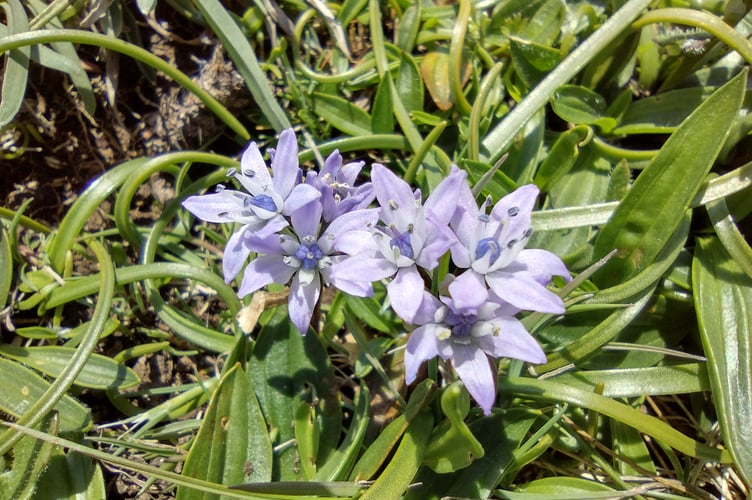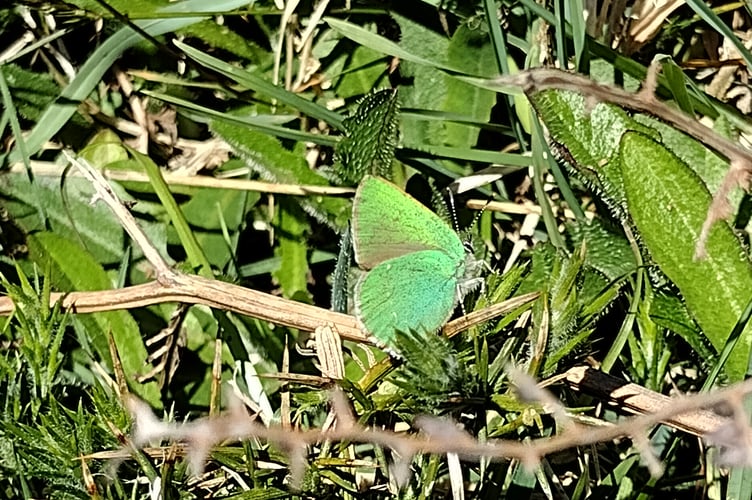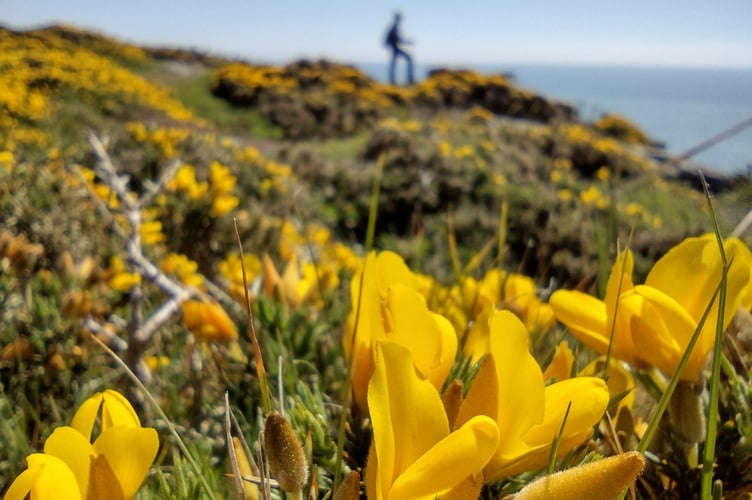The older I get, the more I want to play hooky on sunny days.
“Sorry, it will have to wait. I need something to write about for my Nature Diary and besides, I need to drag Oli out for some fresh air and to return his National Trust t-shirt.” That was my excuse for abandoning a variety of work and domestic responsibilities in favour of a trip to the stunning coastline at Soar. Also, the weather was unbelievably perfect and I didn’t want to miss a minute of it.
The t-shirt had been weighing on my conscience for…ahem, several years (I’m too embarrassed to admit how many) after my younger son finished his conservation volunteering stint with the Trust whilst at sixth form. I was chuffed at how keen Oli was to come along and after dropping back his shirt, we parked and headed towards the sea. Leaving the farmland behind us and walking out onto the cliff-top, Oli suddenly grabbed my arm and said, “Stop!” Pausing to take in the view, I heard him inhale deeply and at that moment a warm, fragrant blanket of coconut engulfed me. Gorse! Gorse, golden and heaped in mounds and hummocks as far as the eye could see, stretching out in both directions along the coastal strip. Gorse: golden like Jersey butter; as rich in its yellowness as it was intoxicating in its sun-warmed scent. We breathed it in. Heavenly.

Moving closer to the edge we found a good spot to sit and eat our sandwiches. Looking to the east, the great rocky cliffs of Bolt Head, and to the west, Bolberry Down and Bolt Tail, rose impressively above the sea. Viewing the scene from this vantage point, it was hard to imagine a more striking colour contrast as the yellow-crowned gorse met the azure sea.
Replete and careful not to leave a trace of our visit, we headed west. As we walked, I told Oli that one of the things I was most hopeful of seeing was a Green Hairstreak butterfly as I hadn’t been in the right place at the right time to see one for several years. Just then at ankle height, a tiny butterfly fluttered past and I squeaked with surprise and delight as I caught a flash of green. Amused at this, apparently, instant wish-granting, Oli joined me in tracking the flitting creature as it jinked about over the low-growing vegetation. Finally it settled and we took turns to get close-up views through binoculars. Only the underwings are green and of a vibrant hue you would more likely associate with tropical insects. At rest, wings are always folded and they catch the light like shot-silk, flashing between yellowish-lime and the blue-green of verdigris as the butterfly angles itself either

towards or away from the sun. From top to bottom on the hindwing, it looks as if someone has painted the thinnest of white lines with a slightly shaky hand, hence the name, Hairstreak.
Hairstreaks belong to a family which includes the Blue and Copper butterflies. Blues, especially the Large Blue, are well-known for their specialized relationship with ants during the chrysalis stage and there is evidence that many Hairstreak butterflies, including the Green, do too. The chrysalis of this species has been shown to overwinter within ant nests, attracting its host by exuding sweet secretions and producing irresistible churrings and cluckings from its sound organ, a characteristic feature of this family, prompting the ants to tend and protect it. Apparently, the stridulations of the Green Hairstreak chrysalis are audible to the human ear, sounding like a series of squeaks, which was why this curious phenomenon first came to be investigated. I wonder, how many of us would be sufficiently inquisitive to take an interest in such a tiny brown, hairy blob in the first place, let spend hours studying it.

As we continued along the path, we noticed several more, including a pair tumbling around each other in flight. Most probably, this was territorial behaviour between males protecting a perching post. Despite having a wide range of foodplants and a UK distribution stretching from Inverness to the tip of Cornwall, the Green Hairstreak is not common. Colonies are self-contained and localised, making them vulnerable to habitat loss.
Further on, we encountered a young woman taking advantage of the clifftop breeze to dry her tent. She was walking the South West Coast Path and I asked her if she had spotted any green butterflies along the way. When she said no, I showed her the photograph and she gasped at the colour, amazed.
There is so much more to recount: hillsides, pale blue with Spring Squill flowers; stonechat, cirl bunting and skylark; sunshine and sea. It was a beautiful time of gathering treasures for the heart.





Comments
This article has no comments yet. Be the first to leave a comment.